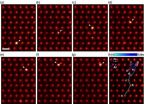Magnetic superconductor: Strange bedfellows
2014-10-14
(Press-News.org) Chemists at Ludwig-Maximilias-Universitaet (LMU) in Munich have synthesized a ferromagnetic superconducting compound that is amenable to chemical modification, opening the route to detailed studies of this rare combination of physical properties.
Superconductivity and ferromagnetism – the "normal" form of magnetism, such as that found in the familiar horseshoe magnet – are like chalk and cheese: They generally don't go together. Ferromagnets are magnetic because the parallel alignment of adjacent electron spins in the iron atoms generates a strong internal magnetic field. Almost all known superconductors, on the other hand, form pairs of "anti-aligned" electrons and exclude magnetic field lines from their interiors. But LMU chemists have discovered a new material in which these two properties can coexist: "We have synthesized a new compound which exhibits both characteristics at the same time: It is a ferromagnetic superconductor," says Professor Dirk Johrendt of the Department of Chemistry. "This is an important advance, which opens up new research opportunities in the field," he adds.
Ferromagnetic superconductors are not unknown, but they are exceedingly rare, and almost always exhibit both properties simultaneously only when they are cooled to temperatures close to absolute zero (-273°C). "The layered material which we have synthesized, (Li,Fe)OH(FeSe), has the great advantage that it works at higher temperatures, which are easier to achieve and handle in the laboratory," says Johrendt.
The new compound is made up of stacks of alternating superconducting iron selenide (FeSe) and ferromagnetic lithium-iron hydroxide (Li,Fe)OH layers. When the material is cooled, electrical resistivity drops to zero in the iron selenide layer at temperatures below -230°C, and superconductivity emerges. At somewhat lower temperatures, the iron atoms in the (Li,Fe)OH layer become ferromagnetic, but superconductivity persists nevertheless.
In cooperation with physicists from the Technical University in Dresden and the Paul Scherrer Institute in Villingen (Switzerland), the LMU researchers have demonstrated that the magnetic field generated by the (Li,Fe)OH layers penetrates into the interleaved superconducting layers – spontaneously and in the absence of externally applied fields. This novel state of matter is referred to as a spontaneous vortex phase. The few substances which exhibit this effect cannot easily be chemically modified and require ultracold temperatures, making more detailed investigation very difficult. "Our new compound for the first time gives us the chance to explore the influence of chemical modification on the coexistence of superconductivity and ferromagnetism, so that it should soon be possible to carry out more extensive studies of this fascinating phenomenon," Johrendt concludes.
INFORMATION:
ELSE PRESS RELEASES FROM THIS DATE:
2014-10-14
The climate is getting warmer, the ice sheets are melting and sea levels are rising – but how much? The report of the UN's Intergovernmental Panel on Climate Change (IPCC) in 2013 was based on the best available estimates of future sea levels, but the panel was not able to come up with an upper limit for sea level rise within this century. Now researchers from the Niels Bohr Institute and their colleagues have calculated the risk for a worst-case scenario. The results indicate that at worst, the sea level would rise a maximum of 1.8 meters. The results are published ...
2014-10-14
WASHINGTON, Oct. 13, 2014 — Whether it's a plain cheese, a deep-dish stacked with meats or a thin-crust veggie delight, there's just something about pizza that makes it delicious. There's a lot of chemistry that goes into everything from dough to sauce to toppings to, of course, cheese. There's also a very specific chemical reaction at work on every single slice, no matter what toppings you choose. Check out the latest episode here: http://youtu.be/tOkCgAwhh9U.
Subscribe to the series at Reactions YouTube, and follow us on Twitter @ACSreactions to be the first to ...
2014-10-14
BUFFALO, N.Y. — An oral biologic medication has successfully treated chronic, precancerous inflammation in the intestine, according to results of an animal study authored by an MD/PhD student in the University at Buffalo School of Medicine and Biomedical Sciences.
The study is featured on the cover of the current issue of Cancer Research; it was published online ahead of print in September. The journal's editors characterized the study's findings as "striking."
Inflammatory cells in the colon, or polyps, are very common after the age of 50. The average 60-year-old ...
2014-10-14
Tropical Storm Vongfong continues to weaken as it tracks across the big islands of Japan, and NASA satellite data showed that westerly wind shear is taking its toll on the storm's structure.
On Oct. 12 at 0500 UTC (1 a.m. EDT), the MODIS instrument aboard NASA's Aqua satellite captured an image of Tropical Storm Vongfong approaching Japan. Despite weakening to a tropical storm, Vongfong still appeared to have an eye as its northeastern quadrant blanketed the large island of Kyushu, Japan. By 11 a.m. EDT, Maximum sustained winds had dropped to 55 knots (63 mph/102 kph). ...
2014-10-14
The Eastern Caribbean islands were getting the brunt of Tropical Storm Gonzalo as the storm slowly moved through on Oct. 13. NASA's Terra satellite and NOAA's GOES-East satellite provided data on the storm. Gonzalo is the sixth named storm in the Atlantic Ocean Hurricane Season.
On Oct. 12 at 15:00 UTC (11:00 a.m. EDT), NASA's Terra satellite flew over Tropical Storm Gonzalo while it moved over the Lesser Antilles. The MODIS instrument captured a visible image of the storm that showed a concentration of strong thunderstorms around the center of circulation and in a thick ...
2014-10-14
The fifth named Atlantic storm didn't maintain hurricane status long. Fay became a hurricane late on Oct. 12 and by early on Oct. 13, had weakened back to a tropical storm.
A visible image from NOAA's GOES-East satellite on Oct. 13 at 1145 UTC (7:45 a.m. EDT) showed Tropical Storm Fay northeast of Bermuda and Tropical Storm Gonzalo over the Lesser Antilles. Fay appeared circular, but didn't have the signature shape of a tropical storm like Gonzalo, with bands of thunderstorms spiraling into the center. The image was created by the NASA/NOAA GOES Project at NASA's Goddard ...
2014-10-14
OAK RIDGE, Tenn., Oct. 13, 2014 -- Researchers at the Department of Energy's Oak Ridge National Laboratory have obtained the first direct observations of atomic diffusion inside a bulk material. The research, which could be used to give unprecedented insight into the lifespan and properties of new materials, is published in the journal Physical Review Letters (06 October 2014, DOI: 10.1103/PhysRevLett.113.155501).
"This is the first time that anyone has directly imaged single dopant atoms moving around inside a material," said Rohan Mishra of Vanderbilt University who ...
2014-10-14
CHAMPAIGN, Ill. — When Illinois researchers set out to investigate a method to control how DNA moves through a tiny sequencing device, they did not know they were about to witness a display of molecular gymnastics.
Fast, accurate and affordable DNA sequencing is the first step toward personalized medicine. Threading a DNA molecule through a tiny hole, called a nanopore, in a sheet of graphene allows researchers to read the DNA sequence; however, they have limited control over how fast the DNA moves through the pore. In a new study published in the journal Nature ...
2014-10-14
For decades, scientists thought that neurons in the brain were born only during the early development period and could not be replenished. More recently, however, they discovered cells with the ability to divide and turn into new neurons in specific brain regions. The function of these neuroprogenitor cells remains an intense area of research. Scientists at the National Institutes of Health (NIH) report that newly formed brain cells in the mouse olfactory system — the area that processes smells — play a critical role in maintaining proper connections. The results ...
2014-10-14
Scientists have created a drug for type 2 diabetes that is switched on by blue light, which they hope will improve treatment of the disease.
Diabetes drugs that promote the release of insulin from the pancreas can in some cases cause side effects due to their actions on other organs such as the brain and heart. Some can also stimulate too much insulin release, causing blood sugar levels to drop too low.
To help create better drugs, researchers at Imperial College London and LMU Munich adapted an existing type of drug called a sulfonylurea so that it changes shape when ...
LAST 30 PRESS RELEASES:
[Press-News.org] Magnetic superconductor: Strange bedfellows







